Read our handy guide on how to fix a pothole on your driveway, private path, tarmac patio area or private road. Permanent pothole repairs is what it’s all about (let’s avoid having to fill them again next year!). We take you through the tools you need, which tarmac fillers are most suitable and how to get started.
Potholes on public roads and main carriageways can be a huge safety risk to drivers, cyclists and pedestrians. And that’s not even mentioning the damage they can cause to vehicles (RAC estimates point to one-third of UK cars suffering damage due to potholes).
If you notice a pothole on a public road, including an A road or motorway, that poses a danger to traffic, please report it immediately to either your local council or the Highways Agency.
This tutorial is for filling potholes on asphalt or tarmac surfaces. Concrete paths would require way more work and proper equipment.
What is a pothole?
A pothole is a depression in the surface of a road, path or carpark where the tar has worn away. It will typically cause damage to tyres on vehicles and bicycles. They can also affect a car’s wheel alignment, suspension and framework.
How do potholes form?
Potholes are formed when cracks develop on the surface of a road due to the tarmac heating up during the day and cooling overnight. Rainwater enters these cracks and, when the temperature drops below freezing, the water will freeze and expand, causing the cracks to swell. With added stress from vehicle traffic, potholes develop and will gradually widen.
How can potholes be repaired?
A pre-mixed pothole repair filler – otherwise known as cold-lay tarmac – is the main material you will need to fill and fix a pothole.
If your driveway, private path or private road has developed a pothole, you can repair it yourself. With the right tools and tarmac formula, you can make the surface flush and smooth again to avoid causing any damage and keep the area looking smart.
For larger potholes, you may need to hire a professional with heavy equipment to compact the tarmac filler.
However much you enjoy DIY, the less time spent filling up gaps in your driveway means more time on valuable other jobs. We only ever recommend the permanent method of filling potholes to fix them for good so you won’t be doing the same job again when next winter arrives.
Continue reading to find out how to fix potholes yourself and decide whether you would prefer to use a contractor.
Fixing the problem – what you'll need
For permanent pothole repairs you’ll need a few extra tools and materials to properly prepare the hole and seal the pothole filler in place:
- Safety gloves
- Goggles
- A circular saw to cut a neat, vertical ‘picture frame’ around the pothole
- A brush for removing loose tarmac
- A shovel
- Pre-mixed cold-lay tarmac (read on for the recommended aggregate sizes)
- A cold jointing spray to seal the edges
- A hand-held tarmac tamper or earth rammer
- Over-banding tape to prevent water ingress (and a blow torch for application)
Over-banding tape such as Instaband Eco is a thermoplastic tape that helps to prevent water seeping around the new pothole. This is especially important if you do not have a petrol plate compactor or wacker plate to fully compact the uncured tarmac.
A Hyundai compactor is available to buy with either a 87cc or 196cc petrol engine. This mechanic compactor will help create a flush surface in no time and save your back too.
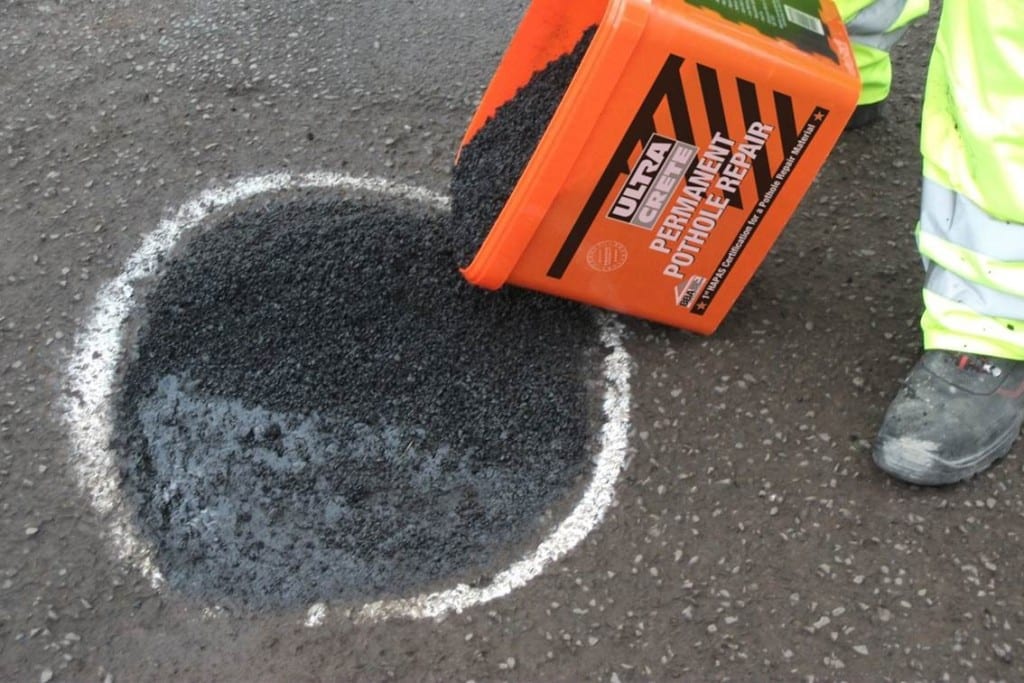
Choosing a pothole filler
When it comes to filling potholes, it’s important to choose the right filler for the job.
Cold-lay tarmac is available in various sizes of aggregate to suit the depth of the pothole and the type of vehicle traffic that is likely in the area.
For example, for major carriageways and roads, a stronger, skid-resistant cold-lay tarmac is a must. Cold-lay tarmacs such as Tough Patch are recommended for filling potholes on roads that are heavily trafficked and require more skid-resistance.
Reducing the likelihood of skids is also important for car parks featuring turning circles for lorries.
Pothole repairs for driveways and paths
Most potholes in driveways and private footpaths should be minor in size, so look for a product containing aggregate of between 3–6mm. Always check the product is HAPAS approved, which means it has passed the strict and rigorous independent testing measures as part of the Highways Authority Product Approval Scheme. It’s not just to do with safety, but it also means the product has proven its long-term durability so your pothole repair is long lasting, and ideally permanent.
Both Permanent Pothole Repair 3mm and Instant Road Repair 6mm are high-quality, fine-grade, HAPAS-approved tarmac pothole fillers that come in handy-sized, pre-mixed tubs or bags that are ready to pour into the pothole. Most potholes in driveways and private paths should be fairly shallow. These two pothole repair mixtures can be used up to fill potholes up to 100mm deep.
Commercial pothole repairs for roads and car parks
If you’re a contractor working on a public road, highway or a private job for a carpark, you’ll need a larger size of aggregate in the cold-lay tarmac to ensure the material can withstand the stress from heavy traffic. Skid resistance is also an important factor. Our review of cold-lay tarmacs for public roads and heavy traffic will be coming soon.
Red tarmac repair for driveways and paths
Most bitumen and asphalt is made of black tarmac, however red-coloured tarmac is available too. Luckily the team at Ultracrete have formulated a red pothole repair material to mend any holes in red tarmac driveways.
If your driveway or pathway is red, use Instant Road Repair 6mm Red to repair the surfaces and avoid your tarmac looking like a patchwork quilt!
What not to use
You may be tempted to buy a ‘cheap’ workaround to premixed, easy-pour cold-lay tarmac, but they can cause more problems.
Avoid DIY asphalt
You can attempt to mix-up a batch of asphalt yourself, but it might not be the right consistency. You would need a road roller to mix it properly, which is not an option if you’re only fixing the pothole by hand. Plus, if you use too much bitumen or filler, your patch will end up being weaker than any pothole that was there before.
Most professional contractors opt for premixed cold-lay asphalt, even on larger pothole repair jobs. Ready-to-pour asphalt, like Ultracrete’s Instant Road Repair, takes away the extra hassle of mixing and offers a water-tight repair job every time.
Avoid concrete pothole repairs
Although concrete would technically work for filling in a hole, using concrete is way more dangerous than mixing your asphalt because its temperature is about 100 degrees hotter, making it impossible to apply without risking severe burns on hands and feet.
When using concrete as a pothole filler, it is challenging to get the exact amount of mixture needed. Too much and you have excessive concrete on your hands. Too little and you’re back to the drawing board to do another mix.
How to fix a pothole
Like with most jobs, successful pothole repairs are all about the preparation. Cold-lay tarmacs cure almost immediately, so the hole will need to be fully cleared of debris and prepped before you take the quick-to-cure tarmac out of the bag.
Here’s our failsafe way of preparing and fixing a pothole after ensuring you have the tools and materials for the job:
- Use a brush and/or pointed trowel to remove any dirt and debris from the hole
- Ensure there is no standing water in the hole
- Cut a neat ‘picture frame’ with straight, vertical edges around the repair area with a circular saw
- Remove the new loose bits of tarmac or debris
- Use a cold joint spray to seal the vertical edges and base of the hole
- Gently apply pressure to the bag of cold-lay tarmac to soften it
- Pour the first layer to a depth of 45mm and compact with a hand tamp
- Reapply cold joint spray to the edges and base, add another layer and tamp again
- On the final layer, use the tarmac tamper to compact until flush with the adjacent surface
- Apply over-banding tape around the edges to protect the fill from water entering
Once applied, the cold-lay tarmac will set almost immediately. It can take pedestrian traffic straight away and can withstand vehicle traffic within moments. It’s that easy!
Watch the video to see the process of filling a pothole in action. Please note, this process involves using a petrol-powered wacker plate, but a hand tamp is fine for smaller jobs. We just recommend applying an overbanding tape to ensure there is no water ingress.
Some things to consider
Check the weather
Make sure the weather conditions allow for the cold-lay tarmac to cure properly.
Cold-lay tarmacs such as Instant Road Repair and Permanent Pothole Repair can be used in most types of weather except extreme weather. With these products, and most other cold-lay tarmacs, ensure the temperature will not drop below freezing during application or hit above 30°C. Extremely hot spells can soften the binder within the tarmac.
Another thing to keep your eye on is the rain. Cold-lay tarmacs can generally be applied during mild showers. However, heavy rain risks filling the pothole up with water, which reduces the quality of the cure and the overall standard of the fill.
If you are filling potholes during wet weather, use Permanent Pothole Repair Wet. This specially formulated product can easily handle heavy showers without risking the product’s overall quality.
The importance of using a circular saw
When fixing potholes, there are still some people who simply clear the hole of debris and fill it with cold-lay tarmac before tamping it down.
While this process seems logical, it is very common for these pothole repairs to fail.
Consider whether you ever spotted a pothole that had popped out. And have you noticed potholes failing and needing filling again, sometimes within the space of a few months?
The permanent way to fix a pothole is by using a circular saw, ideally with a diamond blade, to cut a neat, vertical-edged shape around the pothole itself. What you’re left with is a rigid picture frame with straight, flush edges.
Cold-lay tarmac and pothole repair fillers do not adhere properly to rough, unprepared edges. With an added cold joint spray sealant, such as Ultracrete SCJ, your pothole fix will be a professional and long-lasting job.
How to soften hardened tarmac
You can easily soften cold-lay tarmac that has hardened while being stored.
With the tarmac still in its plastic bag, gently roll your knee against it to manipulate the material and make it malleable. Some added light pressure will help the tarmac return to its usual consistency.
Always layer the tarmac
For the best results, apply layers of tarmac, fully compacting each layer and applying a cold joint spray before adding each extra layer.
Layering gives you the opportunity to ensure each layer is fully compacted. What you are working towards is making sure there are no gaps or voids for water to creep into and that will cause your filling job to fail.
We recommend each layer being a maximum of 45mm deep and compacting it to 30mm. The fact you can easily lose 15mm with each layer after compacting demonstrates the necessity to layer and compact each time.
Safety first
Always wear gloves when touching anything abrasive like sandpaper, stone, bitumen, or any other material that could leave your skin red with a rash or painful chemical burns.
Patching asphalt yourself is not as simple as it sounds, so be sure to put safety first and wear gloves, goggles, and a mask if you don’t want your face burned by bitumen or dust particles.
And be careful to avoid spilling any asphalt on clothes. Uncured tarmac will burn through clothing fabric and even onto your skin if you’re not properly protected.
If you’re not skilled with tools or are not physically strong enough for hard work, don’t attempt to fill a pothole by yourself. Hire a contractor, especially for larger projects as heavy equipment is often required.
Top reason why you should fix potholes yourself
Fixing your own potholes can save you money on paying a professional to come and fix it for you.
The good news is, with the right tools and materials, most people have the necessary skills for repairing a pothole themselves.
If you have potholes on a driveway, private road or pathway, and know how to safely use a circular saw, our tutorial above on fixing potholes takes you through what to do to fill and fix them permanently.
Contractors are available for such jobs too. So if you have any doubt, hire a professional. Search for local pothole repair or tarmac surfacing contractors. If the repair job is for a road, you may want to consider hiring a contractor with a Street Works Qualifications Register (SWQR) ID card.
As mentioned earlier, if you do spot a pothole on a public road or carriageway, contact either your local council or the Highways Agency to report it. There is a handy postcode look-up tool on the government’s website to find the right contact.
Fixing potholes on private roads
An extra level of caution is needed if you are repairing a pothole on a private road that vehicles are likely to use during your fix. If this is the case, you may be best to contact a local pothole repair contractor to be on the err on the side of caution.
When repairing potholes on a private road, you should:
- Wear bright or reflective clothing so people can easily see you
- Use cones or a reflective barrier to steer cars away from your working area
- Assess the risks of hitting cables or gas lines – call an expert immediately if there are any
- Ensure there are no children or pets around, especially when using a circular saw
- Be sure to use work gloves, eye protection and a dust mask
What are the best products for fixing potholes?
Choosing the right filler for the job is essential. Things you should consider when choosing the best cold-lay tarmac for the job are:
Size of the pothole
Generally speaking, most domestic potholes will be much smaller than the size of potholes that can develop on our public roads and carriageways.
For domestic use – on driveways, paths and private roads – either Permanent Pothole Repair 3mm or Instant Road Repair 6mm will both do the job fine (see the advice below on which is best for surfaces withstanding vehicles). They are both HAPAS approved and can fill potholes of up to 100mm deep.
If you have a larger pothole on your hands (of more than 100mm deep), it will be a much more extensive repair job. In these cases, we strongly recommend hiring a professional tarmac repair contractor to resurface the area.
Will the area be used by vehicles?
The key question to ask when choosing a product is about the use of the area.
If you are filling a pothole on a footpath or cycle lane, opt for either Permanent Pothole Repair 3mm or Instant Road Repair 6mm.
However, if the pothole is in an area of low to moderate vehicle traffic, i.e. on a private road, driveway or carpark, instead go for a more skid-resistant formula with Permanent Pothole Repair 3mm.
A much hardier and stronger formula must be used for heavily trafficked areas. Either Tough Patch or Permanent Pothole Repair Wet would be the best choice to prevent undue skids and accidents.
Colour of the tarmac
Choose Instant Road Repair Red if you have a red-tarmaced driveway or pathway. All other cold-lay tarmacs come in black.
Weather during application
Best practice is to avoid heavy showers during application as this will fill up the pothole with standing water, often to the detriment of the tarmac formula.
However, if wet weather cannot be avoided, choose Permanent Pothole Repair Wet for the job.
Other essential materials
A sealant, such as cold joint bitumen spray, and bonding tape are two other essential materials for permanently fixing potholes. Many contractors are opting for Ultracrete SCJ spray for a reliable sealant and Ultracrete Instaband Eco for the over-banding tape.
For the best results with over-banding tape, use a blow torch to securely seal the tape around the pothole repair and prevent water ingress.
Our top tips for success
In conclusion, if you’re skilled with hand tools and have a strong back, here’s what you’ll need to fix a pothole: a brush and/or pointed trowel, a circular saw (preferably with a diamond blade), a bag or tub or cold-lay tarmac, a can of cold joint spray, a hand tamp, and bonding tape.
Focus on layering for the best success with filling a pothole and compacting it so there are no voids. This is where the cold joint spray and bonding tape come in as essential extra materials for the job.
Hiring a plate compactor or wacker plate can make the compacting process much easier (and will put less stress on your back from compacting with a hand tool), so consider hiring one if you have a few potholes to fill. Essentially, when you use a plate compactor the fill is likely to have no voids at all.
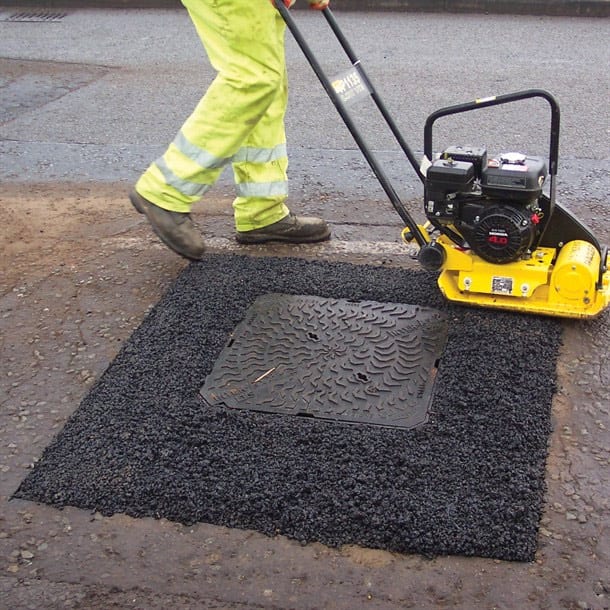
Contact the tarmac experts for more advice
If you still have questions about the process or which product to choose for your pothole fix, give our team a call on 0330 122 1025 (Mon–Fri, 8.30am–5.30pm). We are valued cold-lay tarmac stockists for council contractors, pothole repair professionals and tarmac surfacing experts, and would be happy to talk you through the best options for your job, no matter the size of your repair job.
Click-and-collect is available for all our products from our Tamworth depot in Staffordshire. Big discounts are available for pallet and part-pallet deals. Local delivery can be arranged, together with shipping across the country.
Please note, this guide has been written for information purposes only. The Paving Experts cannot be held responsible for any accidents or damages that occur when trying to fix a pothole.




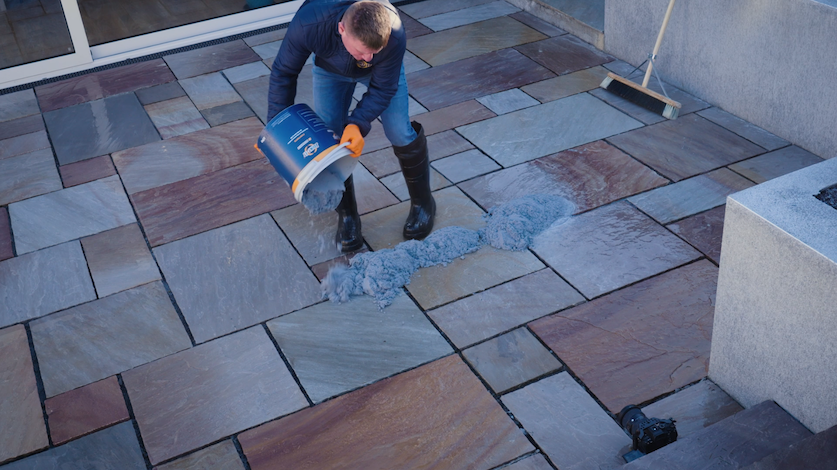
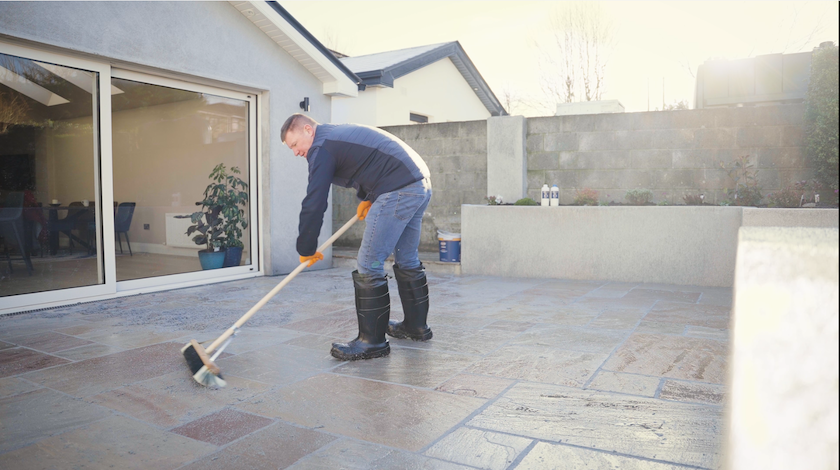


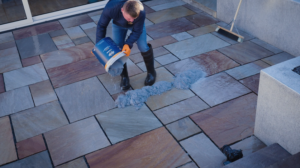

1 thought on “How to fix a pothole: a handy guide”
Can you give any advice about potential trades people in the Edinburgh area who could help fill pot holes on an un adopted road please?